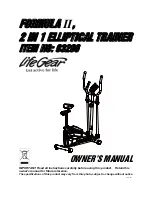
14
Fitness Guide
Perceived exertion level
A simple way to gauge your exercise intensity is to evaluate
your perceived exertion level. While exercising, if you are too
out of breath to maintain a conversation without gasping,
you are working out too hard. A good rule of thumb is to
work to the point of exhilaration, not exhaustion. If you
cannot catch your breath, it’s time to slow down. Always be
aware of these warning signs of overexertion.
Stretching
Before using your product, it is best to take a few minutes
doing some gentle stretching exercises. Stretching prior
to exercise will improve flexibility and reduce chances of
exercise related injury. Ease into each of these stretches with
a slow gentle motion. Do not stretch to the point of pain.
Make sure not to bounce while doing these stretches.
Standing calf muscle stretch
Stand near a wall with the toes of your left foot
about 18” from the wall, and the right foot about
12” behind the other foot. Lean forward, pushing
against the wall with your palms. Keep your heels
flat and hold this position for a count of 15 seconds.
Make sure that you do not bounce while stretching.
Repeat on the other side.
Standing quadriceps stretch
Using a wall to provide balance, grasp your left
ankle with your left hand and hold your foot against
the back of your thigh for 15 seconds. Repeat with
your right ankle and hand.
Sitting hamstring and lower back muscle stretch
Sit on the floor with your legs together and straight out in
front of you. Do not lock your knees. Extend your fingers
towards your toes and hold for a count of 15
seconds. Make sure that you do not bounce
while stretching. Sit upright again. Repeat one
time.
Warming up and cooling down
Warm up
The first 2 to 5 minutes of a workout should be devoted
to warming up. The warm up will limber your muscles and
prepare them for more strenuous exercise. Make sure that
you warm up on your product at a slow pace. The warm up
should gradually bring your heart rate into your Target Heart
Rate Zone.
Cool down
Never stop exercising suddenly! A cool down period of
3-5 minutes allows your heart to readjust to the decreased
demand. Make sure that your cool down period consists of
a very slow pace to allow your heart rate to lower. After the
cool down, repeat the stretching exercises listed to loosen
and relax your muscles to avoid the build up of lactic acid and
post exercise muscle pain.
Achieving your fitness goals
An important step in developing a long term fitness
programme is to determine your goals. Is your primary goal
for exercising to lose weight? Improve muscle? Reduce stress?
Prepare for a race? Knowing what your goals are will help you
develop a more successful exercise programme. Below are
some common exercise goals and the type of activity that will
help you to achieve these goals:
• Weight loss - lower intensity, longer duration workouts.
• Improve body shape and tone - interval workouts, alternate
between high and low intensities.
• Increased energy level - more frequent daily workouts.
• Improved sports performance - high intensity workouts.
• Improved cardiovascular endurance - moderate intensity,
longer duration workouts.
If possible try to define your personal goals in precise,
measurable terms, and then put your goals in writing. The
more specific you can be, the easier it will be to track your
progress. If your goals are long term, divide them up into
monthly and weekly segments. Longer term goals can lose
some of the immediate motivation benefits. Short term goals
are easier to achieve. Your console provides you with several
readouts that can be used to record your progress
Summary of Contents for ALPINE8964-500
Page 6: ...6 6 Parts List...
Page 8: ...8 8 Parts List...


































